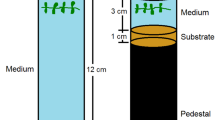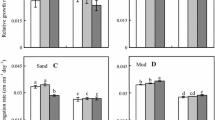Abstract
The propagation of most aquatic macrophytes occurs vegetatively, via fragments. After dispersal, the fragments may exhibit two survival strategies: colonization (the ability to develop roots) and regeneration (the ability to develop new propagules that can disperse). Invasive species, for example, Hydrilla verticillata, are known to have a high potential for dispersal and growth. We experimentally evaluated the colonization and regeneration abilities and growth rates of this species in the early stage of development and compared these properties to the corresponding characteristics of two native species of Hydrocharitaceae (Egeria densa and Egeria najas). The following hypotheses were tested: (1) fragments with apical tips have greater colonization and regeneration abilities and higher growth rates than fragments without apical tips and (2) H. verticillata has greater colonization and regeneration abilities and higher growth rates than other native species of Hydrocharitaceae. Our results showed that both types of fragments had the same ability to colonize, whereas fragments without tips had a higher ability to regenerate. However, fragments with apical tips showed higher growth rates. It is probable that these higher growth rates resulted from apical dominance. H. verticillata had the greatest propagation potential. Its colonization and regeneration abilities and growth rates were greater than those of the native species. These differences can produce competitive advantages for the exotic species in the early stages of development in new habitats and may contribute to understanding the success of the exotic compared to the native species.


Similar content being viewed by others
References
Barrat-Segretain MH, Bornette G (2000) Regeneration and colonization abilities of aquatic plant fragments: effect of disturbance seasonality. Hydrobiologia 421:31–39
Barrat-Segretain MH, Cellot B (2007) Response of invasive macrophyte species to drawdown: the case of Elodea sp. Aquat Bot 87:255–261
Bianchini I Jr, Cunha-Santino MB, Milan JAM, Rodrigues CJ, Dias JHP (2010) Growth of Hydrilla verticillata (L. f.) Royle under controlled conditions. Hydrobiologia 644:301–312
Blackburn RD, Weldon LW, Yeo RR, Taylor TM (1969) Identification and distribution of certain similar-appearing submersed aquatic weed in Florida. Hyacinth Control J 8:17–23
Chadwell TB, Engelhardt KAM (2008) Effects of pre-existing submersed vegetation and propagule pressure on the invasion success of Hydrilla verticillata. J Appl Ecol 45:515–523
Cline MG (1997) Apical dominance. Bot Rev 57:318–358
Cook CDK, Lüönd R (1982) A revision of the genus Hydrilla (Hydrocharitaceae). Aquat Bot 13:485–504
Jiang J, An S, Zhou C, Guan B, Sun Z, Cai Y, Liu F (2009) Fragment propagation and colonization ability enhanced and varied at node level after esca** from apical dominance in submerged macrophytes. J Integr Plant Biol 51(3):308–315
Langeland KA (1996) Hydrilla verticillata (L.F.) Royle (Hydrocharitaceae), “the perfect aquatic weed”. Castanea 61(3):293–304
Langeland KA, Sutton DL (1980) Regrowth of hydrilla from axillary buds. J Aquat Plant Manag 18:27–29
Li K, Liu Z, Gu B (2010) Compensatory growth of a submerged macrophyte (Vallisneria spiralis) in response to partial leaf removal: effects of sediment nutrient levels. Aquat Ecol 44:701–707
Madsen JD, Smith DH (1999) Vegetative spread of dioecious Hydrilla colonies of experimental ponds. J Aquat Plant Manag 37:25–29
Mony C, Koschnick TJ, Haller WT, Muller S (2007) Competition between two invasive Hydrocharitaceae (Hydrilla verticillata (L.f.) (Royle) and Egeria densa (Planch)) as influenced by sediment fertility and season. Aquat Bot 86:236–242
P’yankov VI, Ivanov LA (2000) Biomass allocation in boreal plants with different ecological strategies. Russ J Ecol 31(1):1–7
Pimentel D, McNair S, Janecka J et al (2001) Economic and environmental threats of alien plant, animal, and microbe invasions. Agric Ecosyst Environ 84:1–20
Richardson DM, Pyšek P, Rejmánek M, Barbour MG, Panetta D, West CJ (2000) Naturalization and invasion of alien plants: concepts and definitions. Divers Distrib 6:93–107
Riis T, Sand-Jensen K (2006) Dispersal of plant fragments in small streams. Freshw Biol 51:274–286
Riis T, Madsen TV, Sennels RSH (2009) Regeneration, colonization and growth rates of allofragments in four common stream plants. Aquat Bot 90:209–212
Silveira MJ, Thomaz SM, Mormul RP, Camacho FP (2009) Effects of desiccation and sediment type on early regeneration of plant fragments of three species of aquatic macrophytes. Int Rev Hydrobiol 94:169–178
Sousa WTZ (2011) Hydrilla verticillata (Hydrocharitaceae), a recent invader threatening Brazil’s freshwater environments: a review of the extent of the problem. Hydrobiologia 669:1–20
Sousa WTZ, Thomaz SM, Murphy KJ, Silveira MJ, Mormul RP (2009) Environmental predictors of the occurrence of exotic Hydrilla verticillata (L.f.) Royle and native Egeria najas Planch. in a sub-tropical river floodplain: the Upper River Paraná, Brazil. Hydrobiologia 632:65–78
Sousa WTZ, Thomaz SM, Murphy KJ (2010) Response of native E. najas Planch. and invasive Hydrilla verticillata (L. f.) Royle to altered hydroecological regime in a subtropical river. Aquat Bot 92:40–48
Southwood TRE (1988) Tactics, strategies and templets. Oikos 52:3–18
Van TK, Wheeler GS, Center TD (1999) Competition between Hydrilla verticillata and Vallisneria americana as influenced by soil fertility. Aquat Bot 62:225–233
Vitousek PM, D’Antonio CM, Loope LL, Rejmánek M, Westbrooks R (1997) Introduced species: a significant component of human-caused global change. N Z J Ecol 21(1):1–16
Wang JW, Yu D, **ong W, Han YQ (2008) Above- and belowground competition between two submerged macrophytes. Hydrobiologia 608:113–122
Wu Z, Zuo J, Ma J, Wu J, Cheng S, Liang W (2007) Establishing submersed macrophytes via sinking and colonization of shoot fragments clipped off manually. Wuhan Univ J Nat Sci 12(3):553–557
**e Y, Yu D (2003) The significance of lateral roots in phosphorus (P) acquisition of water hyacinth (Eichhornia crassipes). Aquat Bot 75:311–321
**e Y, An S, Wu B, Wang W (2006) Density-dependent root morphology and root distribution in the submerged plant Vallisneria natans. Environ Exp Bot 57:195–200
Acknowledgments
C. A. Umetsu and H. B. A. Evangelista acknowledge the support of the Brazilian Council of Research (CNPq). We also thank Dr. Liesbeth Bakker and two anonymous reviewers that contributed substantially to improve our manuscript. S. M. Thomaz is especially thankful to CNPq for continuous funding through a Research Productivity Grant. This research was funded by CNPq/MCT through the Long-Term Ecological Research Program, site number 6, and Itaipu Binacional.
Author information
Authors and Affiliations
Corresponding author
Additional information
Handling Editor: Liesbeth Bakker
Rights and permissions
About this article
Cite this article
Umetsu, C.A., Evangelista, H.B.A. & Thomaz, S.M. The colonization, regeneration, and growth rates of macrophytes from fragments: a comparison between exotic and native submerged aquatic species. Aquat Ecol 46, 443–449 (2012). https://doi.org/10.1007/s10452-012-9413-0
Received:
Accepted:
Published:
Issue Date:
DOI: https://doi.org/10.1007/s10452-012-9413-0




